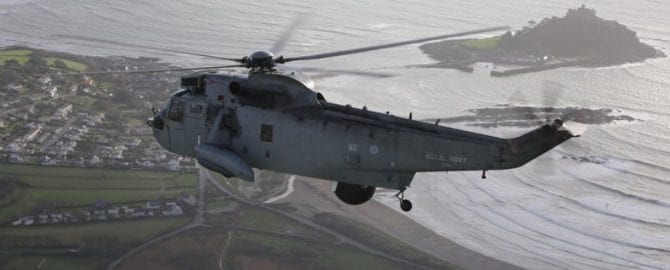It is all eyes on the skies over Cornwall for a farewell fly-past of some of our oldest helicopters.
The Sea King Mk7s, famous for protecting the Navy’s fleet at sea, have served in conflicts around the world.
Now the choppers, known as ‘Old Girl’, are being retired after almost 50 years’ service.
They are set to fly across the Duchy and Devon, leaving RNAS Culdrose at 11am on Wednesday,
When and where can I see the Sea Kings?
The Sea Kings will leave RNAS Culdrose in Helston at 11am, heading east over Falmouth at 11.07am, reaching St Austell Bay at 11.20am and appearing over Saltash at 11.37am.
The choppers will then make their way around Devon, taking in Plymouth, Dartmouth, Paington and Teignmouth, before flying over Burrator Reservoir at 12.55pm.
They will then head back towards west Cornwall, taking in Bodmin Airport at 13.04pm, Padstow at 13.09pm, Newquay Airport at 13.12pm, Penhale Camp at 13.15pm, Chiverton Cross at 13.20pm, Mount Hawke at 13.22pm, Godrevy Lighthouse at 13.28pm, Land’s End Airport at 13.40pm, Sennen Cove at 13.42pm, the Minnack Theatre at 13.44am, Penzance at 13.50pm, St Michael’s Mount at 13.52pm and Tregonning at 13.56pm, before heading back to Helston by 14.00pm.
What do we know about the Sea Kings?
The Sea King Mk7 ‘Airborne Surveillance and Control’ helicopters – known throughout the Royal Navy as Baggers – have been the ‘eyes in the sky’ of the Navy since 2003, searching for aerial threats to the Fleet – or suspicious movements on the ground in support of land forces. They owe their nickname due to the distinctive inflatable black sack or bag on the side of each helicopter.
It may look a rather cumbersome piece of kit from the outside, but inside that sack is the cutting-edge Searchwater 2000 radar capable of remarkably-accurate detection of surface and air targets.
Once enemy units are detected, the helicopter’s observers can direct friendly air, sea or ground forces to intercept – as they did with devastating effect during the fighting in southern Iraq in 2003.
The baggers have got an impressive operational history, having delivered successfully in many conflicts in areas including the Gulf and in Afghanistan where during their five-year mission, they carried out over 2,000 operational sorties in temperatures ranging between 55C and -15C.
The information they fed back to ground forces led to the arrest of 150 terrorist suspects, 40 tonnes of drugs and 172 tonnes of home-made explosives being seized.
However, the airframes are old. Therefore, the capability that the Baggers have delivered, will soon be transferred to the more modern Merlin Mk2 helicopters under a project called Crowsnest.


